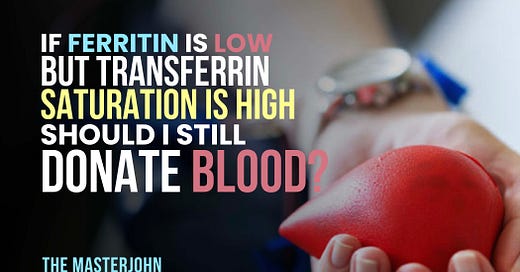Introduction
Question: For someone who is homozygous for the H63D allele of the iron- and hemochromatosis-related HFE gene, if ferritin is low but transferrin saturation is high, should they still donate blood?
H63D is one of the genes that predisposes to hemochromatosis, a condition of iron overload. Most clinicians who work in this area do not consider the H63D allele to be a concern because it's less severe. With that said, most people who are progressive on the iron research front do believe it's a concern. There is literature showing that people can get clinical hemochromatosis from it and you don't have to get clinically hemochromatosis to be worried about iron overload.
My opinion on this is going to be different than someone who is an expert clinician, but is not immersing themselves deeply in the physiological literature about how this works.
I don't have the skills that they have in triaging and filtering who’s ideal for what treatment and looking at large numbers of people that do one or another treatment and knowing intuitively what happens in those — but what I do have is I have immersed myself very deeply in the physiology.
So the way that I look at this is as follows: iron saturation is an estimate of your transferrin saturation. It's a cheaper way to estimate it than to actually measure transferrin saturation, so it's much more common to get iron saturation.
But let's assume that we're talking about actual transferrin saturation or that iron saturation is a good metric of it. That's your short-term iron storage. Ferritin is your long-term iron storage. The defect in the H63D allele, same for the C282Y allele of the HFE gene, the two moderate and severe hemochromatosis alleles. Allele is a variant of the gene.
In normal physiology what happens is transferrin acts as a gauge of your iron status. The normal physiological levels are between 30 and 40 percent. Now being 41 percent doesn't mean you have a disease, we're not talking about diagnosis here, we're talking about understanding the physiology.
Mechanistically this is designed so that as you go from 30 to 40 percent and especially as you go over 40 percent that communicates the signal to a hormonal system that says you have more iron than you need. So you ramp down iron absorption and you ramp up ferritin. Why do you ramp up ferritin? Because you have more than you need in your short-term storage, so that's when you put it into your long-term storage. Also, because ferritin is a protective response that prevents you from having free iron.
Free iron is bad because it feeds pathogens and it makes infections worse. Free iron is bad because it causes oxidative stress and causes wear and damage on your tissues. And so to avoid free iron you ramp up ferritin while you take down your absorption from food at the same time.
And now is that a problem at all? You could debate that, but if you're just talking, if you're not talking about diagnosis and you're talking about wellness, and you're talking about health management then… What I would want to do myself in that situation is I would first of all not let the ferritin go under 20, and if it's going near there I would be getting a CBC to make sure I'm not making myself anemic.
And so I would not stop donating blood just because the ferritin is going down 60, 50, 40, I would consider it a gray area, it would be my preference to focus on the transferrin saturation and get it consistently under 40%. You get the pinprick to look at your serum iron levels, they're not going to let you donate blood if you're actually in the danger zone of anemia.
So I would get the CBC to be proactive about it.
Listen to the Audio
I highly recommend watching the video above but you can also listen to the audio here:
Read the Transcript or Leave a Comment
Masterpass members have access to the transcript below.
Masterpass members can also read and leave comments below. Non-members can read and leave comments on the general podcast page.
Learn more about the Masterpass here.




